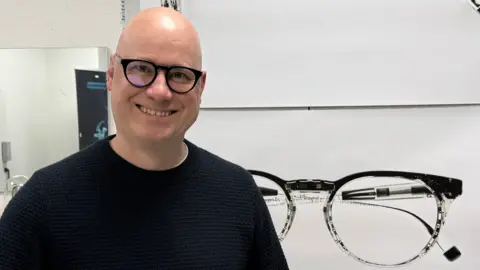The article titled **’Autofocus’ specs promise sharp vision, near or far** delves into an innovative eyewear technology developed by IXI, a Finnish company. The CEO and co-founder, Niko Eiden, describes these glasses as looking like ordinary eyewear but integrated with advanced technology, featuring lenses that can adapt to different vision needs dynamically. During a Zoom call, Eiden demonstrated the glasses, explaining that they utilize liquid crystals that can be adjusted electrically, allowing for a remarkable flexibility to correct vision for users who typically require multiple pairs of glasses for near and distant viewing.
What makes these glasses particularly captivating is the built-in eye-tracking capability, which enables the lenses to instantly respond to the wearer’s vision requirements at any specific moment. This effectively eliminates the need for traditional bifocal or varifocal lenses, which require wearers to change their gaze to different sections of the lens for clarity. Eiden acknowledges the uphill battle for consumer acceptance and emphasizes the importance of aesthetics, stating, “We need to make our products actually look like existing eyewear,” as many prospective users are averse to adopting technology that makes them appear like cyborgs.
The article highlights that while the technology behind IXI’s eyewear is promising, smart glasses often have a tumultuous past, referencing Google Glass, which faced consumer rejection for its unsettling appearance and perceived usefulness. IXI aims to avoid that pitfall by ensuring their glasses retain the familiar, attractive characteristics of everyday eyewear.
The need for such technology is becoming increasingly relevant. As the global population ages, vision impairments like presbyopia, a condition that affects the ability to focus on close objects, are expected to rise. Meanwhile, conditions like myopia or short-sightedness are also on the rise, prompting a need for innovative solutions in eyewear. Conventional glasses have not changed significantly over the years, typically consisting of bifocal lenses that create a distinct separation between sections for varying distances. Autofocus lenses, on the other hand, promise smooth transitions between focal points, potentially transforming the user experience.
Eiden candidly shares insights about the early versions of IXI’s autofocusing lenses, which he admits were subpar, suffering from hazy visuals, particularly at the edges. However, ongoing development and testing have yielded promising results, with trials indicating smooth adjustments responding to users’ focus shifts from near to far objects. The intricate nature of the eyeglasses necessitates careful attention to fitting since the efficacy of the eye-tracking mechanism relies on proper adjustment to individual wearer characteristics. Product director, Emilia Helin, mentions that while IXI frames are adjustable, they concern delicate electronics within them necessitating a careful balance.
The technology also incorporates a rechargeable battery, promising around two days of battery life under normal use, with the possibility of convenient overnight recharging. However, Eiden remains mum on the launch timeframe and potential pricing but maintains a sense of optimism about consumer reception.
Experts in the field, like Chi-Ho To from Hong Kong Polytechnic University, share mixed feelings regarding the practicality of these glasses for critical tasks like driving or surgery. While recognizing their potential value for regular use, he raises concerns about the implications if vision corrections were to malfunction at a critical moment. Furthermore, Prof. To has been at the forefront of other eyewear innovation, particularly lenses designed to slow the progression of myopia, reflecting ongoing advancements in eyewear technology.
In conclusion, the pursuit of advanced vision solutions such as autofocus lenses by companies like IXI represents a significant breakthrough that could revolutionize how we address common vision problems. As this technology continues to evolve, it holds the promise not only of better vision clarity but also possibly reversing certain eye conditions, which is of immense interest in the global health landscape. The discussions surrounding safety, aesthetics, and practicality will undeniably influence the fate of smart eyewear, making it a compelling field to watch as innovation unfolds.










